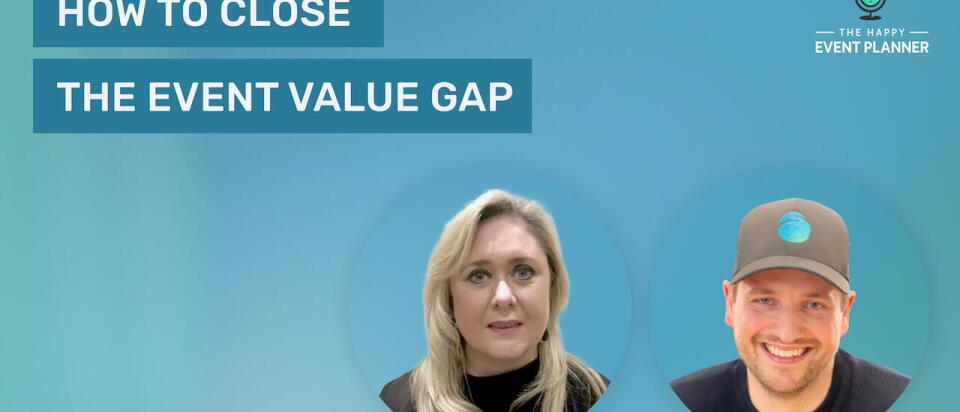
Due to the popular habit of not providing audiences with value in between events, it is common for event professionals to lose a substantial amount of ROI. This absence of value during this duration gave rise to the term 'Event Value Gap.
In this Happy Event Planner webinar recording hosted by Sweap, we spoke to Sophie Ahmed, the SVP of Market Strategy for Hubilo, and Florian Kühne, the CEO and founder of Sweap, about the definition of Event Value Gap, its origins, and how to close it to offer audiences more value. Below are the key takeaways discussed in the webinar.
What Is the Event Value Gap?
The Event Value Gap refers to the period between two events during which an audience is left alone. Event organisers and planners put on the best events possible and focus on a one-time experience, but they subsequently fail to build on the value they have just offered. They do not engage the audience in any conversation or activity, but simply leave them in the dark until a few months later. Then, they receive another email about the next event. Research shows that even professionals miss out on at least 50% of engaging with these audiences and creating long-term relationships, which is a huge loss in terms of ROI.
Engaging with attendees after an event effectively develops your brand, gains additional followers, and ultimately generates sales. Maintaining contact with former and prospective guests expands your network and improves your event planning abilities. Instead of abandoning your audience after giving them an experience of a lifetime during your events, consider how you can leverage the event content. Then, provide value throughout the entire year, not just during the event's allotted time.
The Event Value Gap Has Always Existed
The Event Value Gap has always existed, whether people in the industry realised it or not. Before the advent of social media platforms, event professionals would spend three to four months before an event to promote and increase awareness. After the event took place, everything went dormant until the promotion of the next event.
However, due to the increased popularity of online experiences and virtual events, the realisation that you can engage with and give more value to your audience was realised. Audiences have learned that they cannot only benefit from the event while it happens but also weeks or even months after it. They even demand access to the content they might have missed during the event, shifting the event's value proposition.
Instead of thinking about one event after another, audiences now demand a complete experience, which many event planning and marketing teams are finding challenging to meet this demand.
Key Takeaways
Here are some of the most important takeaways from our session with Florian and Sophie.
The Digitization of Events Plays a Vital Role In Engaging With Audiences
The digitisation of events has provided companies looking to boost brand reputation and visibility with vast opportunities to engage with leads and existing customers. It has proved to generate more leads, which translates into more funnels, an insider look into consumer behaviour, and what content your audience is engaging with more through analytics.
Furthermore, this digitisation also brings brands closer to existing customers. It, indeed, allows both parties to engage and increase their touchpoints. As a result, all this information makes it easier for brands to customise their content to suit their audience throughout the year instead of only during events.
Closing the Event Value Gap Requires a Shift in Mindset and Perspective
To close the Event Value Gap, event professionals and marketers must stop limiting their event experiences to lengthy, one-time experiences. Instead, they should consider creating a relationship with their audiences by learning how to offer real value all year long. Even if you plan fantastic events, you also have to consider what will happen next and how to keep adding value to your audience in the future. Providing post-event value includes:
Online follow-up sessions discussing topics brought up in the event
Creating short clips on social media platforms of the most valuable pieces of event content
Providing on-demand videos of the event
Hosting an event podcast, etc.
Consider the themes that emerged from the event or the queries posed during the Q&A, and then provide follow-up value by responding to your audience's inquiries.
Capturing Event Data Is Crucial in Closing the Event Value Gap
Although collecting audience data is tedious and often complicated, it plays a major role in closing the Event Value Gap. In the past, event professionals used registration forms and post-event questionnaires to get information about their audiences. Although many professionals and marketers still use shorter versions of these documents, access to data analytics has enabled marketers and other professionals to learn more about their audiences. Thus, allowing them to create a more engaging experience before and after an event.
Events Should Be a Team Sport
During the webinar, Florian mentioned that events should ultimately be a team sport despite the distinction between event planners and event marketers in the current group of event professionals. This is because each professional brings to the table a unique ability that will contribute to the event's success. He also stated that the responsibility for closing the Event Value Gap lies with the event marketers. Indeed, they have the role of communicating with their audience and providing a pre-event, on-event, and post-event experience. But, the event marketer has to have a shifted and elevated mindset.
Sales Team Should Be Actively Involved in Events as They Help in Closing the Event Value Gap
Sophie further amplified in the webinar that events should be a collaboration between different teams, including salespeople. The sales and marketing teams can help provide a more valuable event experience by determining what they aim to achieve.
Conclusion
One of the largest event marketing hurdles is closing the Event Value Gap and developing a successful post-event engagement strategy. Although it is crucial in achieving your company and event objectives, many event professionals overlook the period between events. Closing the Event Value Gap aids in creating deeper connections with your audience, promoting your business and brand, and preparing for subsequent events. For more information about how you can actively close the Event Value Gap, join our community, where you can engage with other event professionals.
